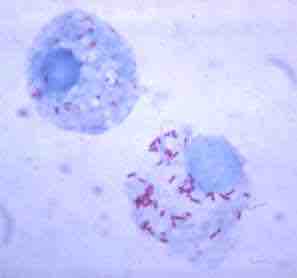Rickettsia is a genus of bacteria that can be transmitted by arthropod vectors to humans, causing disease. Rickettsia species are non-motile, Gram-negative, non-sporeforming, highly pleomorphic bacteria that can present as cocci (0.1 μm in diameter), rods (1–4 μm long), or thread-like (10 μm long). They are obligate intracellular parasites, and must replicate within the cytoplasm of eukaryotic host cells. Rickettsia are one of closest living relatives to bacteria that were the origin of the mitochondria organelle that exists inside most eukaryotic cells. Unlike viruses, Rickettsia possess true cell walls and are similar to other gram-negative bacteria. Despite a similar name, Rickettsia bacteria do not cause rickets, which is a result of vitamin D deficiency.
Rickettsia species are carried by many ticks, fleas, and lice, and cause diseases in humans such as typhus, rickettsialpox, Boutonneuse fever, African tick bite fever, Rocky Mountain spotted fever , Flinders Island spotted fever, and Queensland tick typhus (Australian Tick Typhus). They have also been associated with a range of plant diseases.

A Microbe versus Animal Cell
The large spheres are tick cells. The purple bars and dots are the bacterium Rickettsia rickettsii, which is the causative agent of Rocky Mountain spotted fever. Rickettsia rickettsii is a small bacterium that grows inside the cells of its hosts. These bacteria range in size from 0.2 x 0.5 micrometers to 0.3 x 2.0 micrometers.
Rickettsia can be classified into three groups based on serology and DNA sequencing: spotted fever, typhus, and scrub typhus. All three of these groups contain human pathogens. Recent studies reclassify the scrub typhus group as a new genus - Orienta, and suggest that the spotted fever group should be divided into two clades. Rickettsia are widespread, and can be associated with arthropods, leeches, and protists. Rickettsia found in Arthropods are generally associated with reproductive manipulation (such as parthenogenesis) to persist in host lineage.
Unlike free-living bacteria, Rickettsia species contain no genes for anaerobic glycolysis or those involved in the biosynthesis and regulation of amino acids and nucleosides. In this regard, certain segments of Rickettsia genomes resemble that of mitochondria, and ATP production is the same as that in mitochondria. (With the exception of R. prowazekii, whose genome contains a complete set of genes encoding for the tricarboxylic acid cycle and the respiratory chain complex). The genomes of both Rickettsia and mitochondria are frequently said to be "small, highly derived products of several types of reductive evolution. "